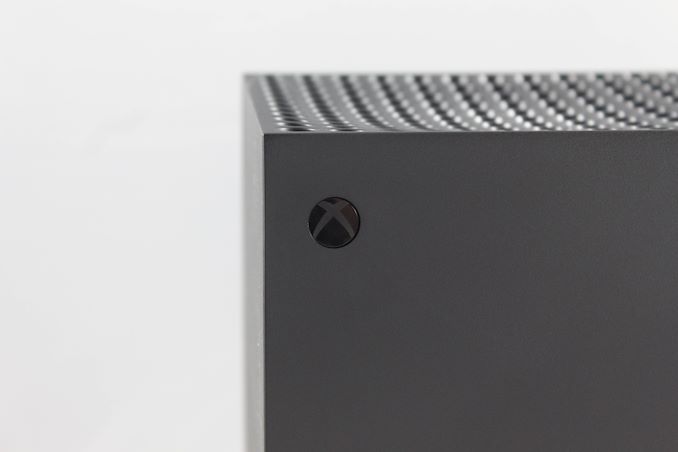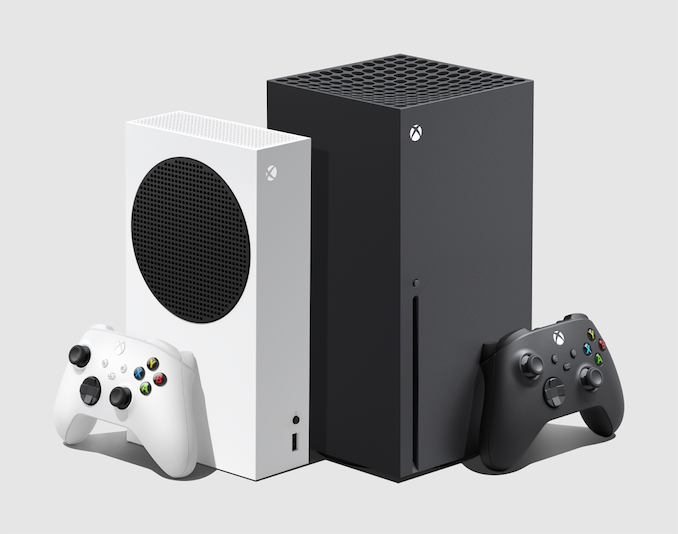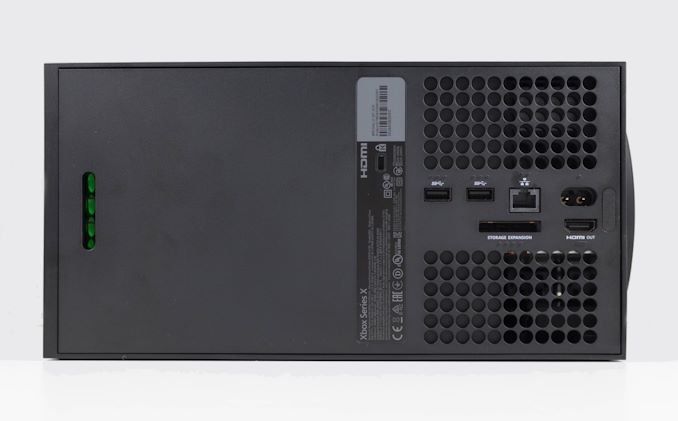The Xbox Series X Review: Ushering In The Next Generation of Game Consoles
by Brett Howse on November 5, 2020 9:00 AM EST
What makes a console generation? The lines have been blurred recently. We can state that the Xbox Series X, and its less-powerful sibling, the Series S, are the next generation consoles from Microsoft. But how do you define the generation? Just three years ago, Microsoft launched the Xbox One X, the most powerful console in the market, but also with full compatibility with all Xbox One games and accessories. With multiple tiers of consoles and mid-generation refreshes that were significantly more powerful than their predecessors – and in some cases, their successors – the generational lines have never been this blurred before.
None the less, the time for a “proper” next generation console has finally arrived, and Microsoft is fully embracing its tiered hardware strategy. To that end, Microsoft is launching not one, but two consoles, with the Xbox Series X, and the Xbox Series S, each targeting a difference slice of the console market both in performance and price. Launching on November 10, 2020, the new Xboxes bring some serious performance upgrades, new designs, and backwards compatibility for not only the Xbox One, but also a large swath of Xbox 360 games and even a good lineup of games from the original 2001 Xbox. The generational lines have never been this blurred before, but for Microsoft the big picture is clear: it’s all Xbox.
The Xbox Series X is the flagship console, and the one we have been teased about for over a year. When launched, it will be the most powerful console in the market. Microsoft learned some lessons from the original Xbox One launch, and they seem keen to not make those mistakes again, so they have partnered with AMD to deliver a console with eight Zen 2 CPU cores paired with an AMD RDNA 2 graphics processor with 12 TFLOPS of performance. With 16 GB of GDDR6 memory, and 1 TB of solid-state storage, the new Xbox Series X targets gamers looking for 4K gaming at 60 FPS, with up to 4K 120 FPS on some titles.
The Xbox Series S goes a different route, with a much more cost-effective console. It still features AMD Zen 2 CPU cores, but a much smaller 4 TFLOP GPU, which is not even as powerful as the Xbox One X from 2017. With 10 GB of GDDR6 and 512 GB of solid-state storage, the Xbox Series S targets 1440p gaming, or, more realistically for televisions, 1080p at up to 120 FPS, and with a large number of people still owning 1080p televisions, the less-expensive console has a definite niche.
Both consoles offer solid-state storage, which is one of the key features of the new generation. While not a new idea, solid-state offers a significant number of performance benefits as have been realized in the PC space for a decade or more, but cost has been prohibitive before.
With any console generation, the glue that holds it together is the games, and Microsoft has chosen a very different course for the Xbox Series X|S. With full backwards compatibility, there is already a large library of games, and games developed for the new consoles will continue to be available on the Xbox One as well, at least for now. Exclusives that are just for the Xbox Series X|S do not exist, which is certainly not how most console launches go. Instead, Microsoft sees the future of gaming in the Xbox Game Pass, which is a subscription service to a buffet of gaming titles.
| Xbox Specification Comparison | ||||||||||||||
| Xbox Series X | Xbox Series S | Xbox One X | Xbox One S | |||||||||||
| CPU Cores | 8C/16T | 8C/16T | 8C/8T | 8C/8T | ||||||||||
| CPU Frequency | 3.8 GHZ 3.6 GHz w/SMT |
3.6 GHZ 3.4 GHz w/SMT |
2.3 GHz | 1.75 GHz | ||||||||||
| CPU µArch | AMD Zen 2 | AMD Zen 2 | AMD Jaguar | AMD Jaguar | ||||||||||
| GPU Cores | AMD RDNA 2 52 CUs 3328 SPs 1.825 GHz |
AMD RDNA 2 20 CUs 1280 SPs 1.565 GHz |
AMD GCN 2 40 CUs 2560 SPs 1172 MHz |
AMD GCN 2 12 CUs 768 SPs 914 MHz |
||||||||||
| Peak Shader Throughput | 12 TFLOPS | 4 TFLOPS | 6 TFLOPS | 1.4 TFLOPS | ||||||||||
| Embedded Memory | None | None | None | 32MB eSRAM | ||||||||||
| Embedded Memory Bandwidth | None | None | None | 218 GB/s | ||||||||||
| System Memory | 16GB GDDR6 | 10GB GDDR6 | 12GB GDDR5 | 8GB DDR3-2133 | ||||||||||
| System Memory Bus | 320-bit | 128-bit | 384-bit | 256-bit | ||||||||||
| System Memory Bandwidth | 10 GB @ 560 GB/s 6 GB @ 336 GB/s |
8 GB @ 224 GB/s 2 GB @ 56 GB/s |
326 GB/s | 68.3 GB/s | ||||||||||
| Storage | 1 TB SSD 802 GB Free |
512 GB SSD 364 GB Free |
1 TB HDD | 500 GB HDD | ||||||||||
| Manufacturing Process | TSMC 7nm | TSMC 7nm | TSMC 16nm | TSMC 16nm | ||||||||||
| Dimensions | 151mm x 151mm x 301mm | 151mm x 275mm x 65mm | 300mm x 240mm x 60mm | 295mm x 230mm x 65mm | ||||||||||
| Weight | 4.44kg | 1.92kg | 3.81kg | 2.9kg | ||||||||||
| PSU | 315W (Internal) |
165W (Internal) |
245W (Internal) |
120W (Internal) |
||||||||||
| Optical Drive | UHD Blu-Ray | None | UHD Blu-Ray | UHD Blu-Ray | ||||||||||
| Wireless | 2x2 802.11ac | 2x2 802.11ac | 2x2 802.11ac | 2x2 802.11ac | ||||||||||
| Launch Price (USD) | $499 | $299 | $499 | $299 | ||||||||||
| Launch Date | 11/10/2020 | 11/10/2020 | 11/07/2017 | 08/02/2016 | ||||||||||
Microsoft has blurred the generational lines significantly with the Xbox Series X|S launch in quite a few ways, and accessory support is definitely one of them. In past console generations, new consoles would have new controllers and all new accessories would be required. That is not the case with the Xbox Series X|S. All Xbox One controllers are 100% compatible, as should be most other accessories such as headphones, and even the Xbox Adaptive Controller. There is one major accessory which is not compatible though, and that is Kinect. Kinect was a major focus of the Xbox One launch, but Microsoft quickly dropped the expensive accessory from being a requirement, and its use-case never materialized in any significant way. Xbox One games that require Kinect will not be compatible with the new Series X|S but all other Xbox One games will be through backwards compatibility. If you still use Kinect and enjoy it, this may seem like a step back, but from personal experience, Kinect will not be missed.
Another loss moving into this generation is the HDMI input which is no longer available. As part of the media push for the Xbox One, it included an HDMI input so you could insert the Xbox between your cable box and TV, allowing cable to be controlled via an IR blaster which could be plugged into the Xbox One. This had some advantages, but the media usage with DVR recording functionality ultimately never materialized, and there were likely only a small group of people taking advantage of this feature.
With the console features that define generations a short list indeed, let us now dig into the technical specifications of the new consoles so we can determine if these are indeed generational updates.












68 Comments
View All Comments
Kangal - Saturday, November 7, 2020 - link
I haven't seen any TV, Radio, or Billboard ads. Even the buzz online has been quite mute.Despite that, 2020 is a bad time for console release. Not only is the pandemic risk a real problem, but the component supply issues are tough, the people having a lot less spending money is massive, and on top of that software and game developers have also been hit.
Now every disadvantage has it's advantage!
1) I think this was the perfect opportunity for MS to one-up and beat the console race, by pulling a "pro move". And what I mean about that is that MS should have trolled Sony, by developing a next-gen console that is launching in December, priced much higher, have worse specs, be much hotter, be much louder, look uglier, have a confusing name, and have gimmicky launch titles. So it's basically a 4K-checkerboard console with NO RayTracing. Yep, even going as far as sending lots of units to game publishers to work on, some individual units to online reviewers, and even limited supply to retailers. This would've meant Sony develops a PS5 that's even worse than now in terms of features (No RayTracing) and specs (20%-60% slower), and at a higher $600 price, to help the company profit-margin.
2) Then at the last minute, bam, MS apologises and cancels the product just before launch. Then cite the covid restrictions, supply issues, etc etc as the culprit. But promise to release the system very soon when they are ready. A slimy business move indeed. It will have the half-baked PS5 competing with itself, which doesn't matter, as PS4 had won the current-gen console race.
3) Then "re-develop" the next-gen console to actually release a year later, in Oct 2021. By this period, they would have stopped Xbox One/S/X production and ended stock. And released the "Xbox Two" as a better named, beautiful console, that runs cold, runs silent, ships with the Elite2 controller, and has a couple awesome exclusive games. It would run all enhanced "XB1X" games, and it supports next-gen games with an output of 4K-HDR-RayTracing with 120fps, but all games are actually rendered in 1080p. So because of the questionable 4TF RDNA +2 GPU its only a slight upgrade (modest upgrade to Base Xbox One), and priced equal to the discounted Xbox OneX at $300. Even worse it lacks a Disc tray, so it is Digital Only which gives a monopoly to MS for game sales and streaming. However, thanks to the much faster 4.0GHz Zen3 CPU, 16GB GDDR6 memory, and the Soldered 512GB nVme SSD, it does support all next-gen titles. So this rounds out the Xbox One era, with no reviewers sent any units, with all retailers having full stock already, it is ready for sale right away, shocks the industry and defeats the 1 year old $600 PS5 on a strict value proposition.
4) But wait, there's more!
Upon release of the Xbox Two, one week later MS holds a press release/announcement. This is their true fifth-gen console aptly named "The Xbox V". It's even better named, more beautiful design, runs silent, runs cool, released cheaper and better than expected. The next day and following, there are ads for it everywhere on TV, Radio, Billboards, and everywhere online. Whilst pre-orders start the next week, for a sweet $500 price, with heaps of stock in MS's warehouses boxed and ready. They would also have a new 5th-gen controller dubbed "XP5" for Xbox Pad 5 with an updated design. It also uses upgraded parts like 4.0GHz Zen3 CPU, a more modern 12TF RDNA2+ GPU, ample 32GB GDDR6 memory, and a 1TB nVme SSD that is user replaceable. Not to mention a much more polished API, Software, and launch titles/exclusives (not gimmicky). Overall there's a huge and noticeable (30%-90%) performance difference between the "half-baked PS5" versus the "enhanced Xbox V". This means PS5 suffers immensely with all third-party releases for the entire generation (not enough RAM, worse APIs, and slower CPU and GPU), and this new console package with such an instant reveal and launch puts Sony at a difficult position. Hence, having an early victory in 2020 for Sony proves useless in terms of profit and market share, and the console race really heats up.
PS: ....with all this hypothetical yet possible scenario laid out, I should note Nintendo lost a similar opportunity with the Switch console. Which could have retailed more/less price, and launched same/earlier period, YET using the new technologies it could have been much more advanced and even more powerful than the PS4, thus supporting all third-party games from the current-gen consoles. It would've extended its effective lifetime, not be obsolete so quickly. Perhaps remain relevant in the next-gen console era as well, instead of relying on gimmicks, fans, and nostalgia.
persondb - Saturday, November 7, 2020 - link
That would require Microsoft to know ahead about the current situation. Because you know, hardware takes a long time to develop and it was likely finalized just before the start of this pandemic. Same for playstation really.Tams80 - Sunday, November 8, 2020 - link
This is what an uninhibited stream of fanboi fantasy looks like.Utterly clueless, impractical, unrealistic, and silly. Move along; nothing to see here.
TesseractOrion - Sunday, November 8, 2020 - link
Total drivel.Kangal - Sunday, November 8, 2020 - link
I concur.Still fun thought exercise. Besides fact is stranger than fiction.
cmdrdredd - Monday, November 9, 2020 - link
People without disposable income have made the PS4 Pro and Nintendo switch disappear from retail supply though. Seems people have more money than you thinkFloridaMan - Friday, November 20, 2020 - link
Sir,Corporate espionage is a real thing. Nearly all tech companies engage in an array of both soft and hard spying to know what the competition is bringing to the table.
AMD would be point entropy in this situation. Not only is a third party designing for both Sony and MS, but their using the same architecture as well. One has less room to differentiate their product within those lines. However, this is beneficial to the consumer as developers are working between a framework rather than having to code for separate entities.
Gone are the days where one might wait a year for game to port. (At least for consoles. The PCMASTERACE still locked behind this constraint on many titles, but we are patient, and mighty! What cannot be unlocked will be emulated, modded or synthesized!)
Yojimbo - Thursday, November 5, 2020 - link
I don't know if that's true or not, as I don't watch any TV. But maybe they feel it would be counterproductive in this environment. Hyping something up that will be in short supply for a while might make people frustrated. And by short supply I don't mean the supply will be low, I mean that demand will already outstrip supply without any advertising.The console market as a whole is probably pretty stable without any advertising, but Sony and Microsoft would want to gain an edge against each other in enthusiasm. So I would expect campaigns to try to influence people. Perhaps at first they will be a bit more subtle? (such as to get their product talked about on gamer youtuber channels, etc...) Then it's out there in people's minds without the direct, implicit promises of availability that come with direct advertising.
MonkeyPaw - Thursday, November 5, 2020 - link
Maybe they know they're facing supply shortages and there's no point in paying for advertising to sell a product that might already be sold out through the end of the year. I think enough gamers knew about PS5 and XSX that a tv commercial wouldn't move the needle.HarryVoyager - Saturday, November 7, 2020 - link
That would be my suspicion. As I understand it, the PS5 and Xbox Series X/S have all, already, completely sold out in most markets, and it will be a while until they've got enough hardware on hand to make more.At that point a big ad blitz is just going to cost you money.